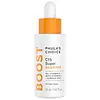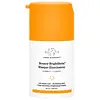What's inside
What's inside
 Key Ingredients
Key Ingredients

 Benefits
Benefits

 Concerns
Concerns

No concerns
 Ingredients Side-by-side
Ingredients Side-by-side

Water
Skin ConditioningAscorbic Acid
AntioxidantGlycerin
HumectantEthoxydiglycol
HumectantPPG-26-Buteth-26
Skin ConditioningMannitol
HumectantTridecapeptide-1
Skin ConditioningPalmitoyl Tripeptide-5
Skin ConditioningErgothioneine
AntioxidantSodium Hyaluronate
HumectantPentylene Glycol
Skin ConditioningPEG-40 Hydrogenated Castor Oil
EmulsifyingBisabolol
MaskingSodium Gluconate
Skin ConditioningDecylene Glycol
Skin ConditioningFerulic Acid
AntimicrobialOryza Sativa Bran Extract
Skin ConditioningTocopherol
AntioxidantPolyacrylate Crosspolymer-6
Emulsion Stabilising1,2-Hexanediol
Skin ConditioningPanthenol
Skin ConditioningSodium Phytate
Sodium Hydroxide
BufferingCitric Acid
BufferingPhenoxyethanol
PreservativeWater, Ascorbic Acid, Glycerin, Ethoxydiglycol, PPG-26-Buteth-26, Mannitol, Tridecapeptide-1, Palmitoyl Tripeptide-5, Ergothioneine, Sodium Hyaluronate, Pentylene Glycol, PEG-40 Hydrogenated Castor Oil, Bisabolol, Sodium Gluconate, Decylene Glycol, Ferulic Acid, Oryza Sativa Bran Extract, Tocopherol, Polyacrylate Crosspolymer-6, 1,2-Hexanediol, Panthenol, Sodium Phytate, Sodium Hydroxide, Citric Acid, Phenoxyethanol
Water
Skin ConditioningAzelaic Acid 10%
BufferingHydroxyethyl Acrylate/Sodium Acryloyldimethyl Taurate Copolymer
Emulsion StabilisingSalicylic Acid 1%
MaskingGlycerin
HumectantCucurbita Pepo Seed Oil
EmollientSalvia Hispanica Seed Oil
MoisturisingSclerocarya Birrea Seed Oil
HumectantPentylene Glycol
Skin ConditioningDiglucosyl Gallic Acid
Niacinamide
SmoothingPhloretin
AntioxidantAllantoin
Skin ConditioningFerulic Acid
AntimicrobialDipotassium Glycyrrhizate
HumectantTremella Fuciformis Sporocarp Extract
AntioxidantBehenic Acid
CleansingGlutathione
Linoleic Acid
CleansingTocotrienols
Skin ConditioningThioctic Acid
AntioxidantLinolenic Acid
CleansingErgothioneine
AntioxidantCholesterol
EmollientCeramide Ns
Skin ConditioningCeramide AP
Skin ConditioningCeramide EOP
Skin ConditioningCeramide Eos
Skin ConditioningCeramide NP
Skin ConditioningSodium Hyaluronate Crosspolymer
HumectantAmylopectin
Ellagic Acid
Skin ConditioningPseudozyma Epicola/Camellia Sinensis Seed Oil Ferment Extract Filtrate
HumectantCaprooyl Phytosphingosine
Skin ConditioningCaprooyl Sphingosine
Skin ConditioningSqualane
EmollientAscorbyl Palmitate
AntioxidantAcetyl Glucosamine
Skin ConditioningPunica Granatum Extract
AstringentDextrin
AbsorbentSebacic Acid
BufferingOryza Sativa Bran Oil
EmollientTocopherol
AntioxidantCeteareth-25
CleansingPhenoxyethanol
PreservativeSorbitan Isostearate
EmulsifyingPolydextrose
HumectantCetyl Alcohol
EmollientCaprylyl Glycol
EmollientChlorphenesin
AntimicrobialPolysorbate 60
EmulsifyingEthylhexylglycerin
Skin ConditioningWater, Azelaic Acid 10%, Hydroxyethyl Acrylate/Sodium Acryloyldimethyl Taurate Copolymer, Salicylic Acid 1%, Glycerin, Cucurbita Pepo Seed Oil, Salvia Hispanica Seed Oil, Sclerocarya Birrea Seed Oil, Pentylene Glycol, Diglucosyl Gallic Acid, Niacinamide, Phloretin, Allantoin, Ferulic Acid, Dipotassium Glycyrrhizate, Tremella Fuciformis Sporocarp Extract, Behenic Acid, Glutathione, Linoleic Acid, Tocotrienols, Thioctic Acid, Linolenic Acid, Ergothioneine, Cholesterol, Ceramide Ns, Ceramide AP, Ceramide EOP, Ceramide Eos, Ceramide NP, Sodium Hyaluronate Crosspolymer, Amylopectin, Ellagic Acid, Pseudozyma Epicola/Camellia Sinensis Seed Oil Ferment Extract Filtrate, Caprooyl Phytosphingosine, Caprooyl Sphingosine, Squalane, Ascorbyl Palmitate, Acetyl Glucosamine, Punica Granatum Extract, Dextrin, Sebacic Acid, Oryza Sativa Bran Oil, Tocopherol, Ceteareth-25, Phenoxyethanol, Sorbitan Isostearate, Polydextrose, Cetyl Alcohol, Caprylyl Glycol, Chlorphenesin, Polysorbate 60, Ethylhexylglycerin
 Reviews
Reviews

Alternatives
Ingredients Explained
These ingredients are found in both products.
Ingredients higher up in an ingredient list are typically present in a larger amount.
Ergothioneine is an amino acid found naturally in mushrooms, grains, and meat. It has antioxidant and skin soothing properties.
This amino acid helps with:
- Maintaining DNA stability and cell reproduction
- Enhances cellular immunity
- Skin brightening
- Anti-aging
- Skin soothing
Ferulic Acid is a plant based antioxidant. By fighting free-radicals, ferulic acid can help reduce the formation of fine lines and hyperpigmentation.
When used with Vitamin C, Ferulic Acid has shown to prevent Vitamin C from breaking down. In other words, it acts as a stabilizer.
Ferulic Acid is sometimes used to preserve food. Foods containing Ferulic Acid include: oats, rice, eggplant, citrus.
In medicine, Ferulic Acid is being studied for helping with diabetes, Alzheimer's, and cardiovascular diseases.
Learn more about Ferulic AcidGlycerin is already naturally found in your skin. It helps moisturize and protect your skin.
A study from 2016 found glycerin to be more effective as a humectant than AHAs and hyaluronic acid.
As a humectant, it helps the skin stay hydrated by pulling moisture to your skin. The low molecular weight of glycerin allows it to pull moisture into the deeper layers of your skin.
Hydrated skin improves your skin barrier; Your skin barrier helps protect against irritants and bacteria.
Glycerin has also been found to have antimicrobial and antiviral properties. Due to these properties, glycerin is often used in wound and burn treatments.
In cosmetics, glycerin is usually derived from plants such as soybean or palm. However, it can also be sourced from animals, such as tallow or animal fat.
This ingredient is organic, colorless, odorless, and non-toxic.
Glycerin is the name for this ingredient in American English. British English uses Glycerol/Glycerine.
Learn more about GlycerinPentylene glycol is typically used within a product to thicken it. It also adds a smooth, soft, and moisturizing feel to the product. It is naturally found in plants such as sugar beets.
The hydrophilic trait of Pentylene Glycol makes it a humectant. As a humectant, Pentylene Glycol helps draw moisture from the air to your skin. This can help keep your skin hydrated.
This property also makes Pentylene Glycol a great texture enhancer. It can also help thicken or stabilize a product.
Pentylene Glycol also acts as a mild preservative and helps to keep a product microbe-free.
Some people may experience mild eye and skin irritation from Pentylene Glycol. We always recommend speaking with a professional about using this ingredient in your routine.
Pentylene Glycol has a low molecular weight and is part of the 1,2-glycol family.
Learn more about Pentylene GlycolPhenoxyethanol is a preservative that has germicide, antimicrobial, and aromatic properties. Studies show that phenoxyethanol can prevent microbial growth. By itself, it has a scent that is similar to that of a rose.
It's often used in formulations along with Caprylyl Glycol to preserve the shelf life of products.
Tocopherol (also known as Vitamin E) is a common antioxidant used to help protect the skin from free-radicals and strengthen the skin barrier. It's also fat soluble - this means our skin is great at absorbing it.
Vitamin E also helps keep your natural skin lipids healthy. Your lipid skin barrier naturally consists of lipids, ceramides, and fatty acids. Vitamin E offers extra protection for your skin’s lipid barrier, keeping your skin healthy and nourished.
Another benefit is a bit of UV protection. Vitamin E helps reduce the damage caused by UVB rays. (It should not replace your sunscreen). Combining it with Vitamin C can decrease sunburned cells and hyperpigmentation after UV exposure.
You might have noticed Vitamin E + C often paired together. This is because it is great at stabilizing Vitamin C. Using the two together helps increase the effectiveness of both ingredients.
There are often claims that Vitamin E can reduce/prevent scarring, but these claims haven't been confirmed by scientific research.
Learn more about TocopherolWater. It's the most common cosmetic ingredient of all. You'll usually see it at the top of ingredient lists, meaning that it makes up the largest part of the product.
So why is it so popular? Water most often acts as a solvent - this means that it helps dissolve other ingredients into the formulation.
You'll also recognize water as that liquid we all need to stay alive. If you see this, drink a glass of water. Stay hydrated!
Learn more about Water